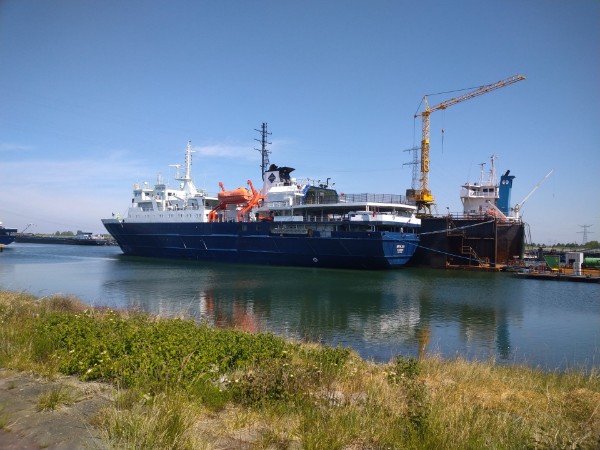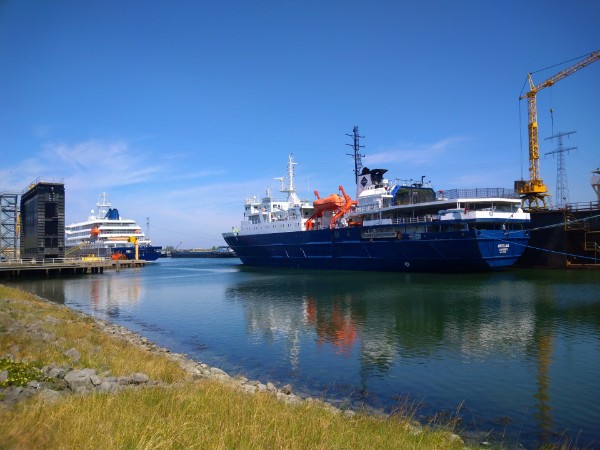Ortelius
Background

Due to the Cocid-19 pandemic in 2020, Ortelius was at home at the Reinderswaal shipyard in Hansweert, The Netherlands when I saw her there at the 18th of may of that year.
In 1989, the Russian company LLC-RN Sakhalinmorneftegaz introduced a new passenger and supplyvessel for the oilfields in the northern Pacific Ocean around the island of Sakhalin. It is an island plagued by controversy, as Russia and Japan both claim possessions on the island. In 1995, a 7,6 magnitude earthquake decimated Neftegorsk, the largest town on the island and 2032 of the 3176 inhabitants died. It was decided to not rebuild the town and since then, the island is mostly uninhabited.
The oilcompany had been founded in 1928 to explore and exploit the northern gas and oilfields near Sakhalin. Between 1977 and 1993 five major new oil and gasfields were discovered and so new supplyships were needed for the continuation of the business.
Construction and general statistics
Launched at the 22nd of december in 1988, the new ship recieved the name Marina Tsvetayeva, named after the renowed Moscow-born poetess (1892-1941). The ship had been built on the Stocznia Gdynia wharf in Gdynia, Poland and was going to fly the Russian flag homeported in Korsakov. The ship has a tonnage of 4575, a lenght of 91,25 meters, width of 17,61 meters and a draft of 5,80 meters. She has six decks excluding the bridge, and three decks are used for the passengers. There was originally space aboard for a total of 182 persons, of whom 49 were crewmembersas well as 133 passaengers. For Oceanwide Expeditions, the ship had been rebuilt for 108 passengers and a crew that consists out of 22 nautical crew, 19 hotelstaff, eight expedition specialists and 1 doctor, totalling 50 crew. She is driven by 1 SULZER-designed dieselengine and operates with 1 controllable pitch propeller. The maximum speed of the ship is 14,3 knots, although her normal service speed is 12 knots. The ship has three sisterships, the David Pashaev (1988), Boris Pasternak (1989) and Igor Farkhutdinov (1991).
Design and style
The ship, planned to sail in northern waters, of course was designed with an ice-strengtened hull as conditions in the waters around Sakhalin required that. For this, she is classed as a 100 1A Super Ice-class ship. Since her beginning as a Russian supplyvessel, the ships public rooms and cabins were designed to be spacious, certainly considering the smallness of the vessel. The public rooms include a bar, a well-stocked library and a large lecture room that also can be used for socialising. The ship doesn't have one larger restaurant, the dining spaces have been spread over three seperate restaurant area's on decks three and four, supplied by one and the same kitchen at deck three.
The ship originally had one suite and several minisuites that all had a seperate bedroom, as well as smaller cabins of which half had private shower and washing facilities. The other half of the cabins had just a washbasin in the cabin but they were located close to the communal toilet and shower facilities. These cabins mostly were meant for the oilworkers on their way to the fields. For Oceanwide Expeditions, the number of cabins has been lower and they are re-organised now all having their private facilities. Still, the cabins are mostly functional and comfortable, more then being luxurious. In the upgrade, the ship had lost the suites as they took up much space so none of the cabins now have a seperate bedroom.
In 2007, the ship recieved a helideck and hangar for two helicopters to be used for expeditions as well as rescuemissions when the need for that should arise.
Carreer

As mentioned, the ship sailed as a passengership and supplyship in the northern Pacific ocean for her owners, before her owning company changed to the Marina Company Sakhalin-Kurils LLC and she was mainly used as an accomodation and supplyship. Also in this year her homeport changed to Kholmsk, although she still flew the Russian flag for her new owners. From december of 2007, the ship was chartered as a true expedition-style cruiseship and started sailing for the Australian-based company Aurora Expeditions. For them, she sailed several cruises around the island of Papua New Guinea, some to the Ross Sea/ Adelie Coast and Commonwealth Bay Region in the Antarctic and also she undertook voyages to the Russian Far East, including a transit through the Bering Strait.
In 2011, the Dutch company Oceanwide Expeditions bought the ship and had her rebuilt at the Reynderswaal Shipyard at Hansweert in The Netherlands into their Ortelius. She was their second larger cruiseship, next to the Plancius that was part of their fleet since 2009. Both ships have had other carreers before, as the Plancius was a ship that had been aquired from the Dutch Navy, formerly known under the name of HMS Tydeman.
Ortelius was named after the Dutch cartographer Abraham Ortelius, born in Antwerp (then in the Southern Netherlands) in 1527 and died in the same town in 1598. He is the inventor of the modern atlas and was named to be the secondmost influential geographer of his time, after Gerardus Mercator. Ortelius is most well remembered when he published the first modern atlas in 1870, named Theatrum Orbis Terrarum, translating to Theater Of The World. At that time it was the most expensive book that had ever been published.
One problem arose in january of 2014, when Ortelius was planned to depart for a 10-day cruise around the Antarctic Peninsula and the anchor system failed. The ship thus never left port and the cruise was cancelled. The same season, an expedition to Snow Hill Island was organized, where passengers were transported by helicopter to enjoy the sight of a colony of emperor penguins and their chicks.
Due to the outbreak of the COVID-19 world-wide pandemic in the spring of 2020, the ship was cutting short her summer program, returning to The Netherlands where she was laid-up at the Reynderswaal Shipyard at Hansweert. She arrived there at the 23rd of april.

Ortelius is shown here at the Reynderswaal Shipyard together with her newer fleetmate Hondius, that was added as the line's first newly built cruiseship in 2019.

